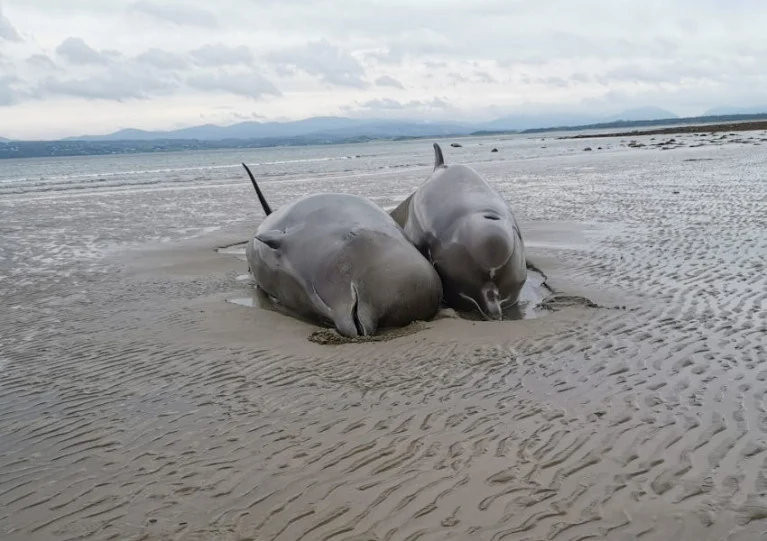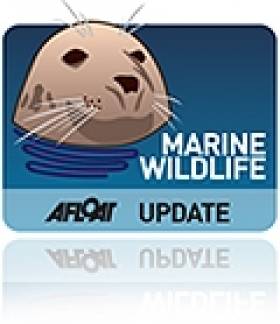Displaying items by tag: Boomerang
No Sign Of One Animal From Deadly Bottlenose Whale Stranding
One of the victims of a deadly mass stranding of bottlenose whales in Donegal last week has not reappeared, according to Highland Radio.
Seven of the marine mammals died in the biggest mass stranding of its kind on record in Ireland, as previously reported on Afloat.ie.
The eighth whale was refloated in the shallows when the tide came in, and hopes were that it would make to back to deeper waters on its own. However it was confirmed to have died the following morning, Thursdasy 20 August.
Local volunteers with the Irish Whale and Dolphin Group (IWDG) have appealed for the public to report any possible sightings, as they are keen to get samples which might reveal more details about the whale pod and its sudden demise.
Elsewhere, rare video has been captured of the humpback whale known as ‘Boomerang’ off West Cork, as RTÉ News reports.
The whale is the third humpback in the IWDG’s records. It was first identified in 2001 thanks to its unique dorsal fin, and has returned to feed in Irish waters regularly over the last two decades.
This story was updated on Monday 31 August to correct details about the refloated bottlenose whale, which was not presumed to have survived as the previous version stated.
Ireland’s Whale Watching Season Is Expanding Says IWDG
#MarineWildlife - The Irish Whale and Dolphin Group’s Pádraig Whooley says he has “lost count” of the number of minke whales seen off West Cork in recent days, as The Irish Times reports.
Whales of various cetacean species are now arriving in Ireland in larger numbers much earlier in the year than their usual appearance in autumn, according to the IWDG’s sightings co-ordinator.
Minke whale numbers between Union Hall and Galley Head have been “exceptional” since last week, says Whooley — who also notes that a pod of humpbacks familiar to West Kerry coastal residents has been feeding off Cork over the past fortnight, while the whale known as Boomerang has been spotted off Waterford.
Elsewhere, the Air Corps Maritime Squadron recently captured some astonishing images of sharks feeding on a whale carcass some 200km northwest of Donegal.
“It's not often that we get sent such clear images of a dead cetacean being scavenged on by several sharks,” said IWDG standings officer Mick O'Connell, “but it does give an indication of the importance of dead animals in the food chain.”
Whale Watchers Rejoice As Boomerang Comes Back With A Humpback Mate
#MarineWildlife - The humpback whale known as Boomerang is back – and this time he may have found a mate, according to The Irish Times.
Last spotted almost exactly a year ago off the south coast at the Cork-Waterford border, as previously reported on Afloat.ie, the humpback formally known as HBIRL3 has been spotted by the Irish Whale and Dolphin Group's Andrew Malcolm in recent days in the same location.
But this time he wasn't alone, as another humpback – HBIRL6, a female who last visited Waterford in 2008, and was previously seen with a juvenile off Co Kerry – was keeping him good company. The irish Times has more on the story HERE.
In other cetacean news, the large whale carcass that washed up on Portstewart Strand earlier this month is believed to have died of natural causes.
Originally confirmed as the remains of an adult female sei whale, the 43-foot behemoth has now been identified as a fin whale, most likely a juvenile, as the Belfast Telegraph reports.
Though the cause of death is "inconclusive", it is thought that due to its peeling skin, thin blubber layer and reduced muscle mass, the whale was already dead for days and decomposing before it washed up on the North Coast beach on 4 October.
Fin whales are the second largest mammal in the world's oceans behind only the blue whale.
'Boomerang' Sighting Marks Bumper Day For Whale Spotting In Celtic Sea
#MarineWildlife - The Irish Whale and Dolphin Group (IWDG) reports on a recent encounter with a humpback whale that's no stranger to our shores.
Marine mammal observer William Hunt was on the RV Celtic Explorer along the south coast where Cork meets Waterford last Wednesday 22 October when the boat came upon HBIRL3, better known as Boomerang.
This marked the first sighting of the distinctively marked male humpback since November 2012, and the ninth year he's been spotted since he was first recorded in August 2001.
The Boomerang sighting was just the tip of the iceberg on an eventful day for cetacean spotting on the annual Celtic Sea Herring Acoustic Survey, which included nine fin whales in various groups seen in close proximity.
The IWDG has much more on the story HERE.
































































